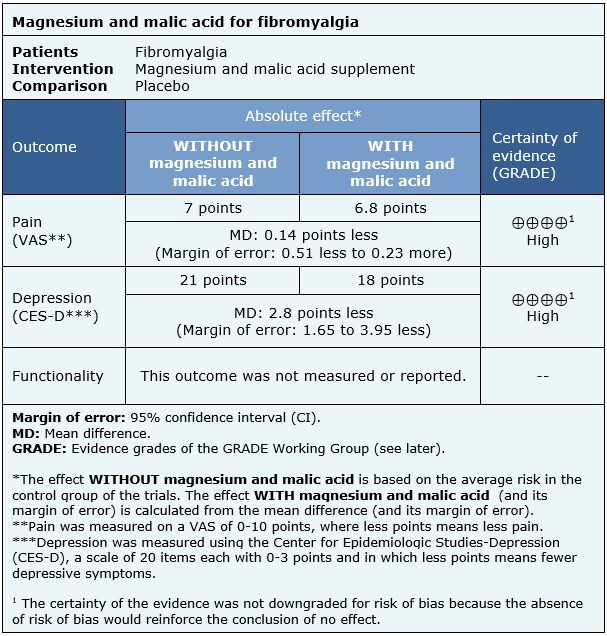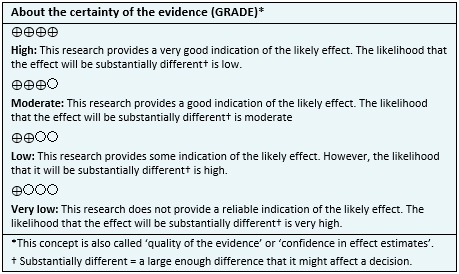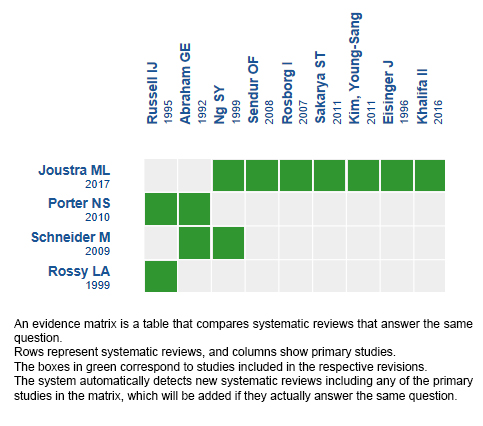Key Words: Fibromyalgia, magnesium, malic acid, Epistemonikos, GRADE
Abstract
INTRODUCTION
Fibromyalgia is characterized by myalgia and a combination of different symptoms including pain, fatigue, insomnia, morning rigidity, depression and a reduction in every-day functioning. Its aetiology is not clear, but it has been suggested that deficiency in certain minerals such as magnesium may play a role both in the physiopathology and in contributing to the symptoms.
METHODS
We searched in Epistemonikos, the largest database of systematic reviews in health, which is maintained by screening multiple information sources, including MEDLINE, EMBASE, Cochrane, among others. We extracted data from the systematic reviews, reanalyzed data of primary studies, conducted a meta-analysis and generated a summary of findings table using the GRADE approach.
RESULTS AND CONCLUSIONS
We identified seven systematic reviews which included 11 primary studies of which one was a randomized trial. Our conclusion is that the use of magnesium and malic acid in patients with fibromyalgia makes little or no difference on pain and on depressive symptoms.
Problem
Fibromyalgia is a nonarticular rheumatic syndrome characterized by myalgia and multiple points of focal muscle tenderness to palpation (trigger points). This condition is often associated with general symptoms, such as sleep disturbances, fatigue, stiffness, headaches, and depression. It has a relatively high global incidence (0.5 to 5%) and affects mainly women aged 20 to 50 years [1].
Although research into this syndrome is increasing, the aetiology is not clear, although the symptoms are thought to be due to nociceptive or neurogenic mechanisms. The peripheral pain is stimulated at a spinal level through a combination of central hyperexcitability and a lack of descending inhibitory control [2].
Magnesium is involved in the modulation of muscle contraction and the regulation of enzyme reactions related to energy metabolism, neurotransmission and cerebral activity. In addition as a trace element, it has a role in the synthesis of ATP and in regulating muscle metabolism. it has been suggested that it may have a role in the physiopathology of fibromyalgia and may contribute to the reduction of symptoms.
Malic acid also has a role in the synthesis of ATP as it contributes to the stability of the mitochondrial membrane, to mitochondrial respiration and oxidative phosphorylation.
Methods
We searched in Epistemonikos, the largest database of systematic reviews in health, which is maintained by screening multiple information sources, including MEDLINE, EMBASE, Cochrane, among others, to identify systematic reviews and their included primary studies. We extracted data from the identified reviews and reanalyzed data from primary studies included in those reviews. With this information, we generated a structured summary denominated FRISBEE (Friendly Summary of Body of Evidence using Epistemonikos) using a pre-established format, which includes key messages, a summary of the body of evidence (presented as an evidence matrix in Epistemonikos), meta-analysis of the total of studies when it is possible, a summary of findings table following the GRADE approach and a table of other considerations for decision-making.
|
Key messages
|
About the body of evidence for this question
|
What is the evidence. |
We found seven systematic reviews [4], [5], [6], [7], [8], [9], [10] which included 11 primary studies [3], [11], [12], [13], [14], [15], [16], [17], [19], [20], [21] of which only one was a randomized controlled trial [11]. The table and thesummary are based on the randomized trial [11], as the observational studies did not increase the certainty of the existing evidence nor added any additional relevant information. |
|
What types of patients were included* |
The trial [11] included 24 patients with a diagnosis of primary fibromyalgia according to the clinical guideline of 1990 of the American College of Rheumatology. The average age of the participants was 49 years old. 87.5% of the participants were female. No exclusion criteria were specified. No other information about the participants, such as severity of their symptoms or plasmatic levels of magnesium or malic acid was available from the systematic reviews. |
|
What types of interventions were included* |
This crossover double blind trial [11] evaluated the use of Super Malic (200 mg malic acid + 50 mg magnesium), 3 tablets taken orally twice a day for 4 weeks, compared to placebo, 3 tablets taken orally twice a day for 4 weeks. The participants were randomly assigned to either the medication and placebo for four weeks, followed by a two week washout period where they took no medication. After the double blinded trial, the participants had another two-week wash-out period with no medication and then entered a six month open-label dose escalation trial. |
|
What types of outcomes |
The trials evaluated multiple outcomes, which were grouped by the systematic reviews as follows:
The outcomes were measured at weeks 0, 4, 6, 10 and 12. |
* The information about primary studies is extracted from the systematic reviews identified, unless otherwise specified.
Summary of findings
The information about the effects of magnesium and malic acid is based on only one trial that included 24 participants [11].
This trial [11] reported pain (24 patients) and depression (24 patients). Functionality was not analyzed by any of the systematic reviews.
The summary of findings is as follows:
- The use of magnesium and malic acid in patients with fibromyalgia makes little or no difference on pain (high certainty evidence).
- The use of magnesium and malic acid in patients with fibromyalgia makes little or no difference on depression (high certainty evidence).

| Follow the link to access the interactive version of this table (Interactive Summary of Findings – iSoF) |

Other considerations for decision-making
|
To whom this evidence does and does not apply |
|
| About the outcomes included in this summary |
|
| Balance between benefits and risks, and certainty of the evidence |
|
| Resource considerations |
|
| What would patients and their doctors think about this intervention |
|
|
Differences between this summary and other sources |
|
| Could this evidence change in the future? |
|
How we conducted this summary
Using automated and collaborative means, we compiled all the relevant evidence for the question of interest and we present it as a matrix of evidence.

Follow the link to access the interactive version: Magnesium and malic acid for fibromyalgia.
Notes
The upper portion of the matrix of evidence will display a warning of “new evidence” if new systematic reviews are published after the publication of this summary. Even though the project considers the periodical update of these summaries, users are invited to comment in Medwave or to contact the authors through email if they find new evidence and the summary should be updated earlier.
After creating an account in Epistemonikos, users will be able to save the matrixes and to receive automated notifications any time new evidence potentially relevant for the question appears.
This article is part of the Epistemonikos Evidence Synthesis project. It is elaborated with a pre-established methodology, following rigorous methodological standards and internal peer review process. Each of these articles corresponds to a summary, denominated FRISBEE (Friendly Summary of Body of Evidence using Epistemonikos), whose main objective is to synthesize the body of evidence for a specific question, with a friendly format to clinical professionals. Its main resources are based on the evidence matrix of Epistemonikos and analysis of results using GRADE methodology. Further details of the methods for developing this FRISBEE are described here (http://dx.doi.org/10.5867/medwave.2014.06.5997)
Epistemonikos foundation is a non-for-profit organization aiming to bring information closer to health decision-makers with technology. Its main development is Epistemonikos database (www.epistemonikos.org).
Potential conflicts of interest
The authors do not have relevant interests to declare.
 Esta obra de Medwave está bajo una licencia Creative Commons Atribución-NoComercial 3.0 Unported. Esta licencia permite el uso, distribución y reproducción del artículo en cualquier medio, siempre y cuando se otorgue el crédito correspondiente al autor del artículo y al medio en que se publica, en este caso, Medwave.
Esta obra de Medwave está bajo una licencia Creative Commons Atribución-NoComercial 3.0 Unported. Esta licencia permite el uso, distribución y reproducción del artículo en cualquier medio, siempre y cuando se otorgue el crédito correspondiente al autor del artículo y al medio en que se publica, en este caso, Medwave.

INTRODUCCIÓN
La fibromialgia es una condición reumática no articular caracterizada por distintos síntomas, donde destacan principalmente el dolor, sensibilidad muscular, fatiga, insomnio, rigidez matinal, depresión y disminución de la funcionalidad cotidiana. Aún no existe claridad respecto de su etiología, pero se ha planteado que la deficiencia de elementos tales como el magnesio podría tener un rol tanto en la fisiopatología de la fibromialgia como también contribuir a sus síntomas clínicos.
MÉTODOS
Realizamos una búsqueda en Epistemonikos, la mayor base de datos de revisiones sistemáticas en salud, la cual es mantenida mediante el cribado de múltiples fuentes de información, incluyendo MEDLINE, EMBASE, Cochrane, entre otras. Extrajimos los datos desde las revisiones identificadas, analizamos los datos de los estudios primarios, realizamos un metanálisis y preparamos una tabla de resumen de los resultados utilizando el método GRADE.
RESULTADOS Y CONCLUSIONES
Identificamos siete revisiones sistemáticas que en conjunto incluyeron 11 estudios primarios, de los cuales solo uno corresponde a un ensayo aleatorizado. Concluimos que el uso de magnesio y ácido málico en pacientes con fibromialgia tiene poco o nulo impacto en dolor y en los síntomas depresivos.
 Authors:
Isadora Ferreira[1,2], Ángela Ortigoza[2,3], Philippa Moore[2,3]
Authors:
Isadora Ferreira[1,2], Ángela Ortigoza[2,3], Philippa Moore[2,3]
Affiliation:
[1] Escola de Medicina, Pontifícia Universidade Católica do Rio Grande do Sul, Porto Alegre, Brasil
[2] Proyecto Epistemonikos, Santiago, Chile
[3] Departamento de Medicina Familiar, Facultad de Medicina, Pontificia Universidad Católica de Chile, Santiago, Chile
E-mail: moore@uc.cl
Author address:
[1] Centro Evidencia UC Pontificia Universidad Católica de Chile Diagonal Paraguay 476 Santiago Chile

Citation: Ferreira I, Ortigoza A, Moore P. Magnesium and malic acid supplement for fibromyalgia. Medwave 2019;19(4):e7632 doi: 10.5867/medwave.2019.04.7632
Submission date: 30/6/2018
Acceptance date: 11/2/2019
Publication date: 28/5/2019
Origin: This article is a product of the Evidence Synthesis Project of Epistemonikos Fundation, in collaboration with Medwave for its publication.
Type of review: Non-blinded peer review by members of the methodological team of Epistemonikos Evidence Synthesis Project.

Comments (0)
We are pleased to have your comment on one of our articles. Your comment will be published as soon as it is posted. However, Medwave reserves the right to remove it later if the editors consider your comment to be: offensive in some sense, irrelevant, trivial, contains grammatical mistakes, contains political harangues, appears to be advertising, contains data from a particular person or suggests the need for changes in practice in terms of diagnostic, preventive or therapeutic interventions, if that evidence has not previously been published in a peer-reviewed journal.
No comments on this article.
To comment please log in
 Medwave provides HTML and PDF download counts as well as other harvested interaction metrics.
Medwave provides HTML and PDF download counts as well as other harvested interaction metrics. There may be a 48-hour delay for most recent metrics to be posted.

- White KP, Harth M. Classification, epidemiology, and natural history of fibromyalgia. Curr Pain Headache Rep. 2001 Aug;5(4):320-9. | PubMed |
- Lidbeck J. Central hyperexcitability in chronic musculoskeletal pain: A conceptual breakthrough with multiple clinical implications. Pain Research & Management. 2002;7(2):81–92.
- Abraham GE, Flechas JD, Yunus MB, Raman KIUP, Raman KK, Wolfe, et al. Management of Fibromyalgia: Rationale for the Use of Magnesium and Malic Acid. Journal of Nutritional Medicine. 1992;3(1):49-59.
- Joustra ML, Minovic I, Janssens KAM, Bakker SJL, Rosmalen JGM. Vitamin and mineral status in chronic fatigue syndrome and fibromyalgia syndrome: A systematic review and meta-analysis. PLoS One. 2017 Apr 28;12(4):e0176631. | CrossRef | PubMed | PMC |
- Porter NS, Jason LA, Boulton A, Bothne N, Coleman B. Alternative medical interventions used in the treatment and management of myalgic encephalomyelitis/chronic fatigue syndrome and fibromyalgia. J Altern Complement Med. 2010 Mar;16(3):235-49. | CrossRef | PubMed |
- Schneider M, Vernon H, Ko G, Lawson G, Perera J. Chiropractic management of fibromyalgia syndrome: a systematic review of the literature. J Manipulative Physiol Ther. 2009 Jan;32(1):25-40. | CrossRef | PubMed |
- Thorpe J, Shum B, Moore RA, Wiffen PJ, Gilron I. Combination pharmacotherapy for the treatment of fibromyalgia in adults. Cochrane Database Syst Rev. 2018 Feb 19;2:CD010585. | CrossRef | PubMed |
- Langhorst J, Häuser W, Bernardy K, Lucius H, Settan M, Winkelmann A, Musial F; Arbeitsgemeinschaft der Wissenschaftlichen Medizinischen Fachgesellschaften. [Complementary and alternative therapies for fibromyalgia syndrome. Systematic review, meta-analysis and guideline]. Schmerz. 2012 Jun;26(3):311-7. | CrossRef | PubMed |
- ldcraft LC, Assefi N, Buchwald D. Complementary and alternative medicine in fibromyalgia and related syndromes. Best Pract Res Clin Rheumatol. 2003 Aug;17(4):667-83. | PubMed |
- Rossy LA, Buckelew SP, Dorr N, Hagglund KJ, Thayer JF, McIntosh MJ, Hewett JE, Johnson JC. A meta-analysis of fibromyalgia treatment interventions. Ann Behav Med. 1999 Spring;21(2):180-91. | PubMed |
- Russell IJ, Michalek JE, Flechas JD, Abraham GE. Treatment of fibromyalgia syndrome with Super Malic: a randomized, double blind, placebo controlled, crossover pilot study. J Rheumatol. 1995 May;22(5):953-8. | PubMed |
- Ng SY. Hair calcium and magnesium levels in patients with fibromyalgia: a case center study. J Manipulative Physiol Ther. 1999 Nov-Dec;22(9):586-93. | PubMed |
- Kim, Young-Sang, Kim, Kwang-Min, Lee, Duck-Joo, et al. Women with Fibromyalgia Have Lower Levels of Calcium, Magnesium, Iron and Manganese in Hair Mineral Analysis. Journal of Korean Medical Science. 2011;26(10).
- Sendur OF, Tastaban E, Turan Y, Ulman C. The relationship between serum trace element levels and clinical parameters in patients with fibromyalgia. Rheumatol Int. 2008 Sep;28(11):1117-21. | CrossRef | PubMed |
- Bazzichi L, Giannaccini G, Betti L, Fabbrini L, Schmid L, Palego L, Giacomelli C, Rossi A, Giusti L, De Feo F, Giuliano T, Mascia G, Bombardieri S, Lucacchini A. ATP, calcium and magnesium levels in platelets of patients with primary fibromyalgia. Clin Biochem. 2008 Sep;41(13):1084-90. | CrossRef | PubMed |
- Khalifa II, Hassan MF, AL-Deri SM, Gorial FI. Determination of Some Essential & Non-Essential Metals in Patients with Fibromyalgia Syndrome (FMS). IJPSR. 2016;8(5):306–311.
- Eisinger J, Gandolfo C, Zakarian H, Ayavou T. Reactive oxygen species, antioxidant status and fibromyalgia. J Musculoskeletal Pain. 1997;5(4):5–15.
- Eisinger J, Zakarian H, Pouly E, Plantamura A, Ayavou T. Protein peroxidation, magnesium deficiency and fibromyalgia. Magnes Res. 1996 Dec;9(4):313-6. | PubMed |
- Sakarya ST, Akyol Y, Bedir A, Canturk F. The relationship between serum antioxidant vitamins, magnesium levels, and clinical parameters in patients with primary fibromyalgia syndrome. Clin Rheumatol. 2011 Aug;30(8):1039-43. | CrossRef | PubMed | PMC |
- Rosborg I, Hyllén E, Lidbeck J, Nihlgård B, Gerhardsson L. Trace element pattern in patients with fibromyalgia. Sci Total Environ. 2007 Oct 15;385(1-3):20-7. | PubMed |
- Macfarlane GJ, Kronisch C, Dean LE, Atzeni F, Häuser W, Fluß E, Choy E, Kosek E, Amris K, Branco J, Dincer F, Leino-Arjas P, Longley K, McCarthy GM, Makri S, Perrot S, Sarzi-Puttini P, Taylor A, Jones GT. EULAR revised recommendations for the management of fibromyalgia. Ann Rheum Dis. 2017 Feb;76(2):318-328. | CrossRef |
 White KP, Harth M. Classification, epidemiology, and natural history of fibromyalgia. Curr Pain Headache Rep. 2001 Aug;5(4):320-9. | PubMed |
White KP, Harth M. Classification, epidemiology, and natural history of fibromyalgia. Curr Pain Headache Rep. 2001 Aug;5(4):320-9. | PubMed | Lidbeck J. Central hyperexcitability in chronic musculoskeletal pain: A conceptual breakthrough with multiple clinical implications. Pain Research & Management. 2002;7(2):81–92.
Lidbeck J. Central hyperexcitability in chronic musculoskeletal pain: A conceptual breakthrough with multiple clinical implications. Pain Research & Management. 2002;7(2):81–92.  Abraham GE, Flechas JD, Yunus MB, Raman KIUP, Raman KK, Wolfe, et al. Management of Fibromyalgia: Rationale for the Use of Magnesium and Malic Acid. Journal of Nutritional Medicine. 1992;3(1):49-59.
Abraham GE, Flechas JD, Yunus MB, Raman KIUP, Raman KK, Wolfe, et al. Management of Fibromyalgia: Rationale for the Use of Magnesium and Malic Acid. Journal of Nutritional Medicine. 1992;3(1):49-59.  Joustra ML, Minovic I, Janssens KAM, Bakker SJL, Rosmalen JGM. Vitamin and mineral status in chronic fatigue syndrome and fibromyalgia syndrome: A systematic review and meta-analysis. PLoS One. 2017 Apr 28;12(4):e0176631. | CrossRef | PubMed | PMC |
Joustra ML, Minovic I, Janssens KAM, Bakker SJL, Rosmalen JGM. Vitamin and mineral status in chronic fatigue syndrome and fibromyalgia syndrome: A systematic review and meta-analysis. PLoS One. 2017 Apr 28;12(4):e0176631. | CrossRef | PubMed | PMC | Porter NS, Jason LA, Boulton A, Bothne N, Coleman B. Alternative medical interventions used in the treatment and management of myalgic encephalomyelitis/chronic fatigue syndrome and fibromyalgia. J Altern Complement Med. 2010 Mar;16(3):235-49. | CrossRef | PubMed |
Porter NS, Jason LA, Boulton A, Bothne N, Coleman B. Alternative medical interventions used in the treatment and management of myalgic encephalomyelitis/chronic fatigue syndrome and fibromyalgia. J Altern Complement Med. 2010 Mar;16(3):235-49. | CrossRef | PubMed | Schneider M, Vernon H, Ko G, Lawson G, Perera J. Chiropractic management of fibromyalgia syndrome: a systematic review of the literature. J Manipulative Physiol Ther. 2009 Jan;32(1):25-40. | CrossRef | PubMed |
Schneider M, Vernon H, Ko G, Lawson G, Perera J. Chiropractic management of fibromyalgia syndrome: a systematic review of the literature. J Manipulative Physiol Ther. 2009 Jan;32(1):25-40. | CrossRef | PubMed | Thorpe J, Shum B, Moore RA, Wiffen PJ, Gilron I. Combination pharmacotherapy for the treatment of fibromyalgia in adults. Cochrane Database Syst Rev. 2018 Feb 19;2:CD010585. | CrossRef | PubMed |
Thorpe J, Shum B, Moore RA, Wiffen PJ, Gilron I. Combination pharmacotherapy for the treatment of fibromyalgia in adults. Cochrane Database Syst Rev. 2018 Feb 19;2:CD010585. | CrossRef | PubMed | Langhorst J, Häuser W, Bernardy K, Lucius H, Settan M, Winkelmann A, Musial F; Arbeitsgemeinschaft der Wissenschaftlichen Medizinischen Fachgesellschaften. [Complementary and alternative therapies for fibromyalgia syndrome. Systematic review, meta-analysis and guideline]. Schmerz. 2012 Jun;26(3):311-7. | CrossRef | PubMed |
Langhorst J, Häuser W, Bernardy K, Lucius H, Settan M, Winkelmann A, Musial F; Arbeitsgemeinschaft der Wissenschaftlichen Medizinischen Fachgesellschaften. [Complementary and alternative therapies for fibromyalgia syndrome. Systematic review, meta-analysis and guideline]. Schmerz. 2012 Jun;26(3):311-7. | CrossRef | PubMed | ldcraft LC, Assefi N, Buchwald D. Complementary and alternative medicine in fibromyalgia and related syndromes. Best Pract Res Clin Rheumatol. 2003 Aug;17(4):667-83. | PubMed |
ldcraft LC, Assefi N, Buchwald D. Complementary and alternative medicine in fibromyalgia and related syndromes. Best Pract Res Clin Rheumatol. 2003 Aug;17(4):667-83. | PubMed | Rossy LA, Buckelew SP, Dorr N, Hagglund KJ, Thayer JF, McIntosh MJ, Hewett JE, Johnson JC. A meta-analysis of fibromyalgia treatment interventions. Ann Behav Med. 1999 Spring;21(2):180-91. | PubMed |
Rossy LA, Buckelew SP, Dorr N, Hagglund KJ, Thayer JF, McIntosh MJ, Hewett JE, Johnson JC. A meta-analysis of fibromyalgia treatment interventions. Ann Behav Med. 1999 Spring;21(2):180-91. | PubMed | Russell IJ, Michalek JE, Flechas JD, Abraham GE. Treatment of fibromyalgia syndrome with Super Malic: a randomized, double blind, placebo controlled, crossover pilot study. J Rheumatol. 1995 May;22(5):953-8. | PubMed |
Russell IJ, Michalek JE, Flechas JD, Abraham GE. Treatment of fibromyalgia syndrome with Super Malic: a randomized, double blind, placebo controlled, crossover pilot study. J Rheumatol. 1995 May;22(5):953-8. | PubMed | Ng SY. Hair calcium and magnesium levels in patients with fibromyalgia: a case center study. J Manipulative Physiol Ther. 1999 Nov-Dec;22(9):586-93. | PubMed |
Ng SY. Hair calcium and magnesium levels in patients with fibromyalgia: a case center study. J Manipulative Physiol Ther. 1999 Nov-Dec;22(9):586-93. | PubMed | Kim, Young-Sang, Kim, Kwang-Min, Lee, Duck-Joo, et al. Women with Fibromyalgia Have Lower Levels of Calcium, Magnesium, Iron and Manganese in Hair Mineral Analysis. Journal of Korean Medical Science. 2011;26(10).
Kim, Young-Sang, Kim, Kwang-Min, Lee, Duck-Joo, et al. Women with Fibromyalgia Have Lower Levels of Calcium, Magnesium, Iron and Manganese in Hair Mineral Analysis. Journal of Korean Medical Science. 2011;26(10).  Sendur OF, Tastaban E, Turan Y, Ulman C. The relationship between serum trace element levels and clinical parameters in patients with fibromyalgia. Rheumatol Int. 2008 Sep;28(11):1117-21. | CrossRef | PubMed |
Sendur OF, Tastaban E, Turan Y, Ulman C. The relationship between serum trace element levels and clinical parameters in patients with fibromyalgia. Rheumatol Int. 2008 Sep;28(11):1117-21. | CrossRef | PubMed | Bazzichi L, Giannaccini G, Betti L, Fabbrini L, Schmid L, Palego L, Giacomelli C, Rossi A, Giusti L, De Feo F, Giuliano T, Mascia G, Bombardieri S, Lucacchini A. ATP, calcium and magnesium levels in platelets of patients with primary fibromyalgia. Clin Biochem. 2008 Sep;41(13):1084-90. | CrossRef | PubMed |
Bazzichi L, Giannaccini G, Betti L, Fabbrini L, Schmid L, Palego L, Giacomelli C, Rossi A, Giusti L, De Feo F, Giuliano T, Mascia G, Bombardieri S, Lucacchini A. ATP, calcium and magnesium levels in platelets of patients with primary fibromyalgia. Clin Biochem. 2008 Sep;41(13):1084-90. | CrossRef | PubMed | Khalifa II, Hassan MF, AL-Deri SM, Gorial FI. Determination of Some Essential & Non-Essential Metals in Patients with Fibromyalgia Syndrome (FMS). IJPSR. 2016;8(5):306–311.
Khalifa II, Hassan MF, AL-Deri SM, Gorial FI. Determination of Some Essential & Non-Essential Metals in Patients with Fibromyalgia Syndrome (FMS). IJPSR. 2016;8(5):306–311.  Eisinger J, Gandolfo C, Zakarian H, Ayavou T. Reactive oxygen species, antioxidant status and fibromyalgia. J Musculoskeletal Pain. 1997;5(4):5–15.
Eisinger J, Gandolfo C, Zakarian H, Ayavou T. Reactive oxygen species, antioxidant status and fibromyalgia. J Musculoskeletal Pain. 1997;5(4):5–15.  Eisinger J, Zakarian H, Pouly E, Plantamura A, Ayavou T. Protein peroxidation, magnesium deficiency and fibromyalgia. Magnes Res. 1996 Dec;9(4):313-6. | PubMed |
Eisinger J, Zakarian H, Pouly E, Plantamura A, Ayavou T. Protein peroxidation, magnesium deficiency and fibromyalgia. Magnes Res. 1996 Dec;9(4):313-6. | PubMed | Sakarya ST, Akyol Y, Bedir A, Canturk F. The relationship between serum antioxidant vitamins, magnesium levels, and clinical parameters in patients with primary fibromyalgia syndrome. Clin Rheumatol. 2011 Aug;30(8):1039-43. | CrossRef | PubMed | PMC |
Sakarya ST, Akyol Y, Bedir A, Canturk F. The relationship between serum antioxidant vitamins, magnesium levels, and clinical parameters in patients with primary fibromyalgia syndrome. Clin Rheumatol. 2011 Aug;30(8):1039-43. | CrossRef | PubMed | PMC | Rosborg I, Hyllén E, Lidbeck J, Nihlgård B, Gerhardsson L. Trace element pattern in patients with fibromyalgia. Sci Total Environ. 2007 Oct 15;385(1-3):20-7. | PubMed |
Rosborg I, Hyllén E, Lidbeck J, Nihlgård B, Gerhardsson L. Trace element pattern in patients with fibromyalgia. Sci Total Environ. 2007 Oct 15;385(1-3):20-7. | PubMed | Macfarlane GJ, Kronisch C, Dean LE, Atzeni F, Häuser W, Fluß E, Choy E, Kosek E, Amris K, Branco J, Dincer F, Leino-Arjas P, Longley K, McCarthy GM, Makri S, Perrot S, Sarzi-Puttini P, Taylor A, Jones GT. EULAR revised recommendations for the management of fibromyalgia. Ann Rheum Dis. 2017 Feb;76(2):318-328. | CrossRef |
Macfarlane GJ, Kronisch C, Dean LE, Atzeni F, Häuser W, Fluß E, Choy E, Kosek E, Amris K, Branco J, Dincer F, Leino-Arjas P, Longley K, McCarthy GM, Makri S, Perrot S, Sarzi-Puttini P, Taylor A, Jones GT. EULAR revised recommendations for the management of fibromyalgia. Ann Rheum Dis. 2017 Feb;76(2):318-328. | CrossRef |Systematization of initiatives in sexual and reproductive health about good practices criteria in response to the COVID-19 pandemic in primary health care in Chile
Clinical, psychological, social, and family characterization of suicidal behavior in Chilean adolescents: a multiple correspondence analysis








